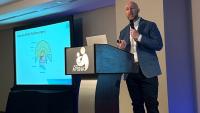Pediatric Aneurysms
Make an Appointment
Our team of dedicated access representatives is here to help you make an appointment with the specialists that you need.
An aneurysm is a bulging, weak area in the wall of an artery. Different kinds of aneurysms require different treatment. Sometimes the best course of action is aneurysm surgery, which may consist of clipping, coiling or bypass surgery.
This page is about pediatric brain aneurysms—brain aneurysms in infants, children and adolescents.
Aneurysms tend to form where arteries branch. The most common kind of aneurysm is a saccular aneurysm. It is the type most likely to rupture and bleed; it is also the type for which the greatest number of treatment options are available.
The less common type is a fusiform aneurysm. In this type of aneurysm, the artery wall does not bulge out in just one spot but rather is swollen all the way around. Fusiform aneurysms are less straightforward to treat, but they are also much less likely to rupture and bleed.
Brain aneurysms in children are not exactly the same as brain aneurysms in adults. Pediatric brain aneurysms tend to arise from different causes and are more likely to be large and complex. At Columbia Neurosurgery, our pediatric neurosurgeons specialize in the diagnosis and treatment of aneurysms in patients ages 0 to 18.
To develop personalized plans that address their patients’ individual needs, our pediatric neurosurgeons work with patients, patients’ families, and a multidisciplinary team of health care providers at Columbia University Irving Medical Center/NewYork-Presbyterian Hospital.
Symptoms
Unfortunately, the majority of aneurysms cause no symptoms until they rupture. A ruptured aneurysm bleeds into the brain. Depending on where the bleeding occurs, this event is called a subarachnoid hemorrhage or an intracerebral hemorrhage. Bleeding in the brain is one cause of a stroke.
A hemorrhage anywhere in the brain is an extreme medical emergency. Symptoms may include:
- Sudden, severe headache (“the worst headache ever”)
- Stiff neck
- Double vision, eye movement problems, sensitivity to light
- Nausea or vomiting
- Loss of consciousness
- Seizure
In some cases, the rupture seals off and bleeding stops on its own. In such cases, the aneurysm can often be surgically treated so that it will never bleed again. In other cases, the bleeding does not stop on its own. No existing surgical or medical intervention is effective quickly enough; in such cases, the rupture is fatal.
Children are more likely than adults to have giant aneurysms. These aneurysms are among the few that may cause symptoms before they burst, simply because they take up so much room in the brain. This is called a mass effect, and it can sometimes lead to a diagnosis before the aneurysm ruptures. Then the aneurysm can often be surgically treated so that it never ruptures.
Mass effect symptoms of an aneurysm (or any other mass in the brain) may include:
- Headache, especially pain above and behind the eye
- Weakness, paralysis or numbness on one side of the face
- Double vision or loss of vision
- Dilated pupils
In children, it is extremely rare that asymptomatic aneurysms are found incidentally (while scanning the brain for another reason).
Diagnosis
The symptoms of brain hemorrhage indicate that an extremely serious problem exists—but they do not indicate what the problem is. In children, similar symptoms are commonly caused by meningitis (infection and swelling of the layers around the brain and spine). So a child with a ruptured aneurysm will receive several emergency tests to determine what serious problem is causing his symptoms. Tests may include:
- CT scan (also called computed tomography or CAT scan): Uses X-rays and a computer to form images of the body’s structures. Usually requires the child to hold still for just a few seconds.
- Lumbar puncture: Uses a needle to withdraw fluid from the space around the spine in the lower back, to look for bleeding or infection.
- MR scan (also called magnetic resonance imaging or MRI): Uses magnets and radiowaves to form images of the body’s structures. Requires a child to lie still inside the scanner for a longer time. Young children may need sedation to keep still long enough.
- Angiogram: Uses a special dye injected into the bloodstream that will make blood vessels visible on a scan. Can be used alone or combined with CT or MRI. Young children often need sedation to lie still long enough.
A child having mass effect symptoms from an unruptured aneurysm will likely receive a similar set of scans to determine what is causing his symptoms.
Risk Factors
Pediatric aneurysms are very rare. In adults, aneurysms typically develop in patients with risk factors that have affected their blood vessels over the course of many years, such as smoking, high blood pressure, long-term excessive alcohol intake and aging. These factors are not usually at play in pediatric patients.
Researchers are working to learn more about the causes of aneurysms in children. The best estimates today are that about 5 to 10 percent of pediatric aneurysms are related to head trauma. About 15 percent of pediatric aneurysms are the result of an infection—this is especially common in children with suppressed immune systems. And up to 33 percent of pediatric aneurysms are associated with underlying conditions. Such conditions include neurofibromatosis type I, connective tissue disorders (Marfan syndrome or the vascular subtype Ehlers-Danlos syndrome), polycystic kidney disease, sickle cell anemia, and malformation of the blood vessels. But many pediatric aneurysms arise for reasons that are not yet understood.
Children who have had aneurysms should usually continue medical follow-up to ensure that the blood vessels in their brains remain healthy throughout their lives.
Treatments
The main surgical treatments for aneurysm are called clipping and coiling. Each is often used to treat saccular aneurysms.
Clipping an aneurysm means pinching it off at the root with a metal clip much like a tiny, specialized clothespin. This prevents blood from flowing into the aneurysm. Aneurysms that are clipped are generally completely cured. To clip an aneurysm, the neurosurgeon performs a craniotomy (temporarily removes a small piece of skull), exposes the aneurysm and places the clip. The skull piece is re-attached with screws and plates, and it soon mends itself like any other broken bone. The screws and plates can stay in place; they never need to be removed.
Coiling means filling the aneurysm with tiny metal coils that block the blood flow and cause the blood inside to clot. Blood therefore ceases pressing against the weakened aneurysm wall. Coiling is performed with tiny instruments that are guided through tubes inserted in the blood vessels. It is an excellent option for aneurysms that cannot be accessed with open surgery.
Bypass surgery may be used in selected cases of saccular or fusiform aneurysm. In this procedure, blood is routed past the section of artery that has an aneurysm. Then the section of artery with an aneurysm can be shut down.

